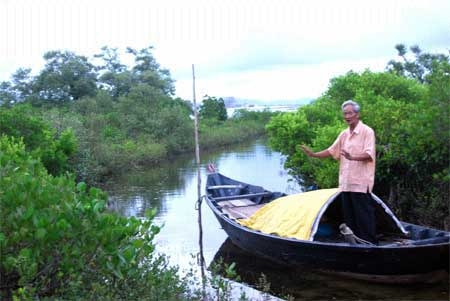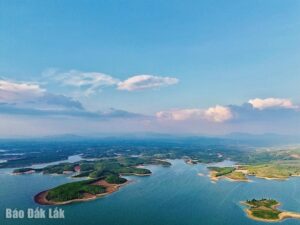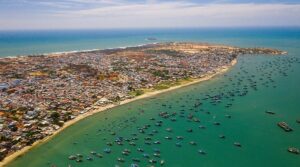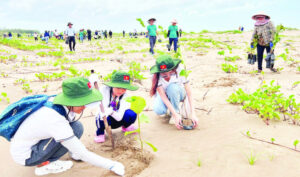All their neighbours were cutting down trees, attracted by the prospect of making money quickly. But people in one village refused to let their forest be destroyed. Today, they're reaping the benefits of that bold decision.

Tree of life: Village elder Pham Thanh Binh, 72, says the mangrove forest provides vital subsistence for local people.
When hundreds of hectares of mangroves in the central province of Quang Nam's Nui Thanh District were cut down to build shrimp ponds about 25 years ago, residents in Dong Xuan Village were determined to say no to a 'fast buck' because they realised the true value of their village's forest.
At the time the decision was viewed as backward, but in the end it has helped them to retain a "museum" of typical mangroves which provide them with sustainable livelihoods and protects them from natural disasters.
Tam Giang is like an oasis, just over 1km from the district's administrative centre.
It's 5am, and Do Thi Lieu is returning from the river that flows through the mangroves. Despite the dark rings around her eyes caused by lack of sleep, she looks cheerful.
"I've caught 2kg of shrimp since 1am, which I can sell for around VND150,000. Our villagers can make a living from the river because we refused to allow our mangroves to be cut down. Fish and shrimp disappeared from many parts of the river a long time ago," says the 49-year-old woman, who has been catching fish on the river since she was very young.
Pham Hong Danh, another fisherman, says: "Fortunately, the river near the mangrove forest still has lots of fish and shrimp for us to rely on during the months that we have to stay away from the sea during the stormy season. The mangroves are a shelter and breeding site for all kinds of shrimp, fish, crabs and snails. All we need is a net and a torch to catch some food."
Village's "protective wall"
The mangroves also provide protection from the fierce storms and floods that have ripped through the region in recent years.
Village chief Pham Van Nhi recalls that during the tropical storm in 2009, locals thought the western part of the village would be destroyed by the strong waves.
"That storm was so strong. In the eastern area, winds and waves were weaker, but a 150m dyke was devastated by waves.
"The western part of the village was untouched despite the fact there are no dykes because it was protected by the mangroves," he says.
Villagers were shocked when nearby areas cut down their mangroves to make way for shrimp ponds.
Huynh Ngoc Anh, 63, the then chief of Tam Giang Commune, recalls: "In 1990, the movement to cut mangroves to build shrimp ponds in Tam Giang began. People were attracted by the benefit of shrimp farming, and in 1992, they hired machines to destroy the mangroves. The noise of the heavy machinery rang out through the village day and night, and by the end of 1997, there were no more mangroves in the commune."
The former chairman says that just a few years later, shrimp farmers began to pay the price for their actions. Having enjoyed initial success, disease decimated their stocks, and the annual cost of flood repair work outweighed what they earned from breeding shrimp. They had lost the protection of the mangrove forests.
Seventy year old village chief Nhi says that his generation treasures the forests that their ancestors left for them.
The riverside village has few fields and the land here is particularly acidic making it difficult to grow crops, so the villagers have to rely on fishing in the river and at sea.
Most of the households earn a living from fishing, and by preserving the mangroves, we can continue to do so for years to come, " he says.
Realising the value of the mangrove forest, residents have planted more trees to further increase the coverage and durability of them.
News of this reached Hue University of Agriculture and Forestry, and a group of scientists from the university arrived in the village in March last year to study the local mangroves.
"They suggested we establish a mangrove conservation club to persuade people to keep preserve and develop the mangroves. The university also promised that they will help the club members raise shrimp and crab in natural conditions later this year," says Do Thi Lieu, head of the club.
The mangrove forest acts as "shield" to prevent flooding and storms, and the loss is conspicuous in areas where people have cut down mangroves to build shrimp ponds, says deputy chief of Tam Giang Commune, Pham Van Chau.
"We must replant the mangrove forests and learn from that lesson. Tam Giang this year will plant 31ha of mangroves on an area that people used to set up shrimp ponds. It will be expensive and it will take a long time for them to grow back, but we understand now that it was unwise to cut them down in the first place," he says.
Pham Van Quyen, the district's deputy chief, also agrees.
"Dong Xuan is my home village. In the days before the locals constructed shrimp ponds, the mangrove forest was like a shield that protected the whole commune. Many of the trees were very old and valuable. Destroying the forest was wrong and it's painful to think back on it. "Fortunately, Dong Xuan Village retained its mangrove forest.
To save the environment, especially during these times of climate change, the district has adopted the model to replant mangroves in Tam Giang. We have also asked provincial authorities to co-ordinate with the Catholic Relief Services in Viet Nam to implement a project to prevent and ease natural disasters in Nui Thanh District, including planting mangroves in three communes adjacent to Tam Giang," Quyen says.















